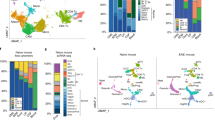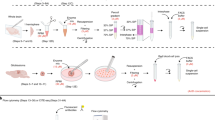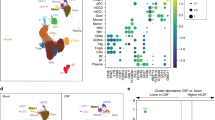Abstract
The brain and its borders create a highly dynamic microenvironment populated with immune cells. Yet characterization of immune cells within the naive brain compartment remains limited. In this study, we used CyTOF mass cytometry to characterize the immune populations of the naive mouse brain using 44 cell surface markers. By comparing immune cell composition and cell profiles between the brain compartment and blood, we were able to characterize previously undescribed cell subsets of CD8 T cells, B cells, NK cells and dendritic cells in the naive brain. Using flow cytometry, we show differential distributions of immune populations between meninges, choroid plexus and parenchyma. We demonstrate the phenotypic ranges of resident myeloid cells and identify CD44 as a marker for infiltrating immune populations. This study provides an approach for a system-wide view of immune populations in the brain and is expected to serve as a resource for understanding brain immunity.
This is a preview of subscription content, access via your institution
Access options
Access Nature and 54 other Nature Portfolio journals
Get Nature+, our best-value online-access subscription
$29.99 / 30 days
cancel any time
Subscribe to this journal
Receive 12 print issues and online access
$209.00 per year
only $17.42 per issue
Buy this article
- Purchase on Springer Link
- Instant access to full article PDF
Prices may be subject to local taxes which are calculated during checkout






Similar content being viewed by others
References
Schwartz, M., Kipnis, J., Rivest, S. & Prat, A. How do immune cells support and shape the brain in health, disease, and aging? J. Neurosci. 33, 17587–17596 (2013).
Louveau, A. et al. Structural and functional features of central nervous system lymphatic vessels. Nature 523, 337–341 (2015).
Engelhardt, B., Vajkoczy, P. & Weller, R.O. The movers and shapers in immune privilege of the CNS. Nat. Immunol. 18, 123–131 (2017).
Prinz, M. & Priller, J. Microglia and brain macrophages in the molecular age: from origin to neuropsychiatric disease. Nat. Rev. Neurosci. 15, 300–312 (2014).
Ginhoux, F. et al. Fate mapping analysis reveals that adult microglia derive from primitive macrophages. Science 330, 841–845 (2010).
Mildner, A., Marinkovic, G. & Jung, S. Murine monocytes: origins, subsets, fates, and functions. Microbiol. Spectr. 4, 4 (2016).
Heppner, F.L., Ransohoff, R.M. & Becher, B. Immune attack: the role of inflammation in Alzheimer disease. Nat. Rev. Neurosci. 16, 358–372 (2015).
Butovsky, O. et al. Identification of a unique TGF-β-dependent molecular and functional signature in microglia. Nat. Neurosci. 17, 131–143 (2014).
Wilson, E.H., Weninger, W. & Hunter, C.A. Trafficking of immune cells in the central nervous system. J. Clin. Invest. 120, 1368–1379 (2010).
Grabert, K. et al. Microglial brain region-dependent diversity and selective regional sensitivities to aging. Nat. Neurosci. 19, 504–516 (2016).
Wes, P.D., Holtman, I.R., Boddeke, E.W.G.M., Möller, T. & Eggen, B.J.L. Next generation transcriptomics and genomics elucidate biological complexity of microglia in health and disease. Glia 64, 197–213 (2016).
Spitzer, M.H. & Nolan, G.P. Mass cytometry: single cells, many features. Cell 165, 780–791 (2016).
Becher, B. et al. High-dimensional analysis of the murine myeloid cell system. Nat. Immunol. 15, 1181–1189 (2014).
Horowitz, A. et al. Genetic and environmental determinants of human NK cell diversity revealed by mass cytometry. Sci. Transl. Med. 5, 208ra145 (2013).
van Unen, V. et al. Mass cytometry of the human mucosal immune system identifies tissue- and disease-associated immune subsets. Immunity 44, 1227–1239 (2016).
Ziv, Y. et al. Immune cells contribute to the maintenance of neurogenesis and spatial learning abilities in adulthood. Nat. Neurosci. 9, 268–275 (2006).
Willing, A. & Friese, M.A. CD8-mediated inflammatory central nervous system disorders. Curr. Opin. Neurol. 25, 316–321 (2012).
Stern, J.N.H. et al. B cells populating the multiple sclerosis brain mature in the draining cervical lymph nodes. Sci. Transl. Med. 6, 248ra107 (2014).
Poli, A. et al. NK cells in central nervous system disorders. J. Immunol. 190, 5355–5362 (2013).
Amir, A.D. et al. viSNE enables visualization of high dimensional single-cell data and reveals phenotypic heterogeneity of leukemia. Nat. Biotechnol. 31, 545–552 (2013).
Qiu, P. et al. Extracting a cellular hierarchy from high-dimensional cytometry data with SPADE. Nat. Biotechnol. 29, 886–891 (2011).
Prinz, M., Priller, J., Sisodia, S.S. & Ransohoff, R.M. Heterogeneity of CNS myeloid cells and their roles in neurodegeneration. Nat. Neurosci. 14, 1227–1235 (2011).
Rose, S., Misharin, A. & Perlman, H. A novel Ly6C/Ly6G-based strategy to analyze the mouse splenic myeloid compartment. Cytometry A 81, 343–350 (2012).
Ransohoff, R.M. & Engelhardt, B. The anatomical and cellular basis of immune surveillance in the central nervous system. Nat. Rev. Immunol. 12, 623–635 (2012).
Prinz, M. & Priller, J. The role of peripheral immune cells in the CNS in steady state and disease. Nat. Neurosci. 20, 136–144 (2017).
Zlokovic, B.V. The blood-brain barrier in health and chronic neurodegenerative disorders. Neuron 57, 178–201 (2008).
Engelhardt, B. Molecular mechanisms involved in T cell migration across the blood-brain barrier. J. Neural Transm. (Vienna) 113, 477–485 (2006).
Zheng, Y. et al. CD86 and CD80 differentially modulate the suppressive function of human regulatory T cells. J. Immunol. 172, 2778–2784 (2004).
Paine, A. et al. IL-2 upregulates CD86 expression on human CD4(+) and CD8(+) T cells. J. Immunol. 188, 1620–1629 (2012).
Peng, H., Sun, R., Tang, L., Wei, H. & Tian, Z. CD62L is critical for maturation and accumulation of murine hepatic NK cells in response to viral infection. J. Immunol. 190, 4255–4262 (2013).
Guilliams, M. et al. Unsupervised High-Dimensional Analysis Aligns Dendritic Cells across Tissues and Species. Immunity 45, 669–684 (2016).
Bruttger, J. et al. Genetic Cell Ablation Reveals Clusters of Local Self-Renewing Microglia in the Mammalian Central Nervous System. Immunity 43, 92–106 (2015).
Streit, W.J., Davis, C.N. & Harrison, J.K. Role of fractalkine (CX3CL1) in regulating neuron-microglia interactions: development of viral-based CX3CR1 antagonists. Curr. Alzheimer Res. 2, 187–189 (2005).
Böttcher, J.P. et al. Functional classification of memory CD8(+) T cells by CX3CR1 expression. Nat. Commun. 6, 8306 (2015).
Wu, Z. CX3CR1(+) B cells show immune suppressor properties. J. Biol. Chem. 289, 22630–22635 (2014).
Hertwig, L. et al. CX3CR1-dependent recruitment of mature NK cells into the central nervous system contributes to control autoimmune neuroinflammation. Eur. J. Immunol. 46, 1984–1996 (2016).
Norden, D.M. & Godbout, J.P. Review: microglia of the aged brain: primed to be activated and resistant to regulation. Neuropathol. Appl. Neurobiol. 39, 19–34 (2013).
Viola, A. & Luster, A.D. Chemokines and their receptors: drug targets in immunity and inflammation. Annu. Rev. Pharmacol. Toxicol. 48, 171–197 (2008).
Hamilton, J.A. Colony-stimulating factors in inflammation and autoimmunity. Nat. Rev. Immunol. 8, 533–544 (2008).
Fuchs, T. et al. The macrophage-TCRαβ is a cholesterol-responsive combinatorial immune receptor and implicated in atherosclerosis. Biochem. Biophys. Res. Commun. 456, 59–65 (2015).
Beham, A.W. et al. A TNF-regulated recombinatorial macrophage immune receptor implicated in granuloma formation in tuberculosis. PLoS Pathog. 7, e1002375 (2011).
Bennett, M.L. et al. New tools for studying microglia in the mouse and human CNS. Proc. Natl. Acad. Sci. USA 113, E1738–E1746 (2016).
Filiano, A.J., Gadani, S.P. & Kipnis, J. How and why do T cells and their derived cytokines affect the injured and healthy brain? Nat. Rev. Neurosci. 18, 375–384 (2017).
Huang, D. et al. The neuronal chemokine CX3CL1/fractalkine selectively recruits NK cells that modify experimental autoimmune encephalomyelitis within the central nervous system. FASEB J. 20, 896–905 (2006).
Hayakawa, Y. & Smyth, M.J. CD27 dissects mature NK cells into two subsets with distinct responsiveness and migratory capacity. J. Immunol. 176, 1517–1524 (2006).
Mueller, S.N. & Mackay, L.K. Tissue-resident memory T cells: local specialists in immune defence. Nat. Rev. Immunol. 16, 79–89 (2016).
Schlitzer, A. & Ginhoux, F. Organization of the mouse and human DC network. Curr. Opin. Immunol. 26, 90–99 (2014).
Mrdjen, D., Hartmann, F. & Becher, B. High dimensional cytometry of central nervous system leukocytes during neuroinflammation. in Inflammation (eds. Clausen, B., Laman, J.D. & Clausen, B.E.) 321–332 (Springer New York, 2017).
Pino, P.A. & Cardona, A.E. Isolation of brain and spinal cord mononuclear cells using percoll gradients. J. Vis. Exp. 48, e2348 (2011).
Finck, R. et al. Normalization of mass cytometry data with bead standards. Cytometry A 83, 483–494 (2013).
Anderson, K.G. et al. Intravascular staining for discrimination of vascular and tissue leukocytes. Nat. Protoc. 9, 209–222 (2014).
Derecki, N., Derecki, N. & Kipnis, J. Mouse meninges isolation for FACS. Protoc. Exch. https://dx.doi.org/10.1038/protex.2014.030 (2014).
Peake, K. et al. Busulfan as a myelosuppressive agent for generating stable high-level bone marrow chimerism in mice. J. Vis. Exp. 98, e52553 (2015).
Livak, K.J. & Schmittgen, T.D. Analysis of relative gene expression data using real-time quantitative PCR and the 2(−ΔΔC(T)) method. Methods 25, 402–408 (2001).
Acknowledgements
We thank S. Schwarzbaum and N. Green for editing the paper; M. Schwartz, S. Shen-Orr, I. Strominger and H. Elyahu for their discussions and advice; G. Vildebaum and L. Saadaa for their help with the experiments; and A. Grau, Y. Sakuory, S. Blumenfeld and the Biomedical core facility at the Technion Faculty of Medicine for technical support and remarks. This study was supported by the Israeli Ministry of Science, Technology & Space (MOST; 3-12070), Prince Center for Neurodegenerative Diseases, Israeli Society for Science (ISF; 1862/15), the FP-7-CIG grant (618654) and the Adelis Foundation.
Author information
Authors and Affiliations
Contributions
B.K. designed and carried out the experiments, analyzed and interpreted the results and wrote the manuscript; T.L.B.-S. and M.S. contributed to the execution and design of the experiments and the analysis of the results and revised the manuscript; T.D. ran the CyTOF samples and contributed to CyTOF analyses and to the manuscript; H.A.-D. carried out the RT-PCR experiments and revised the manuscript; N.T.B. designed the website to present the data and helped with the experiments; T.K. helped with the experiments; and A.R. led the experimental design and interpretation of results and wrote the manuscript.
Corresponding author
Ethics declarations
Competing interests
The authors declare no competing financial interests.
Integrated supplementary information
Supplementary Figure 1 SPADE population bubbles in dot plots.
(a) Illustration of gating strategy for identification of resident and infiltrating myeloid cells. For each cell population, as indicated in the SPADE plot, a histogram of CD45 expression and a dot plot of the markers relevant for cell characterization are presented. Of note, only the selected population is depicted in the dot plots. The relative expression of these markers compared to the entire population is shown in Figure 1. (b) Histograms indicating the expression levels of the selected cell surface markers among the “undefined cells” population.
Supplementary Figure 2 Expression of F4/80 in naive mouse brain immune populations.
Histogram indicating the differential expression of F4/80 on immune cells in the brain compartment (blue) and blood (red). Our analysis indicated very low levels of F4/80 on immune cells in naïve mouse brains. Positive staining (dashed black rectangle) of the antibody is valid according to the blood taken from the same mouse. Representative image of six experiments.
Supplementary Figure 3 Evaluation of cell granularity.
Flow cytometry characterization of granularity in CD11b+/Ly6Clow/Ly6Ghigh cells (granulocytes) compared to CD11b+/Ly6Chigh/Ly6Glow cells (monocytes). Cells are indicated on the left panel. The side scatter (SSC) distribution of these cells, indicative of cell granularity, is shown on the right panel. Representative image of six mice.
Supplementary Figure 4 Identification of CD45+ cells in the brain compartment that were present in the blood circulation at time of mouse perfusion (perfusion validation).
(a) Mice were injected with PE-conjugated anti-mouse CD45 injection (intravenous; i.v.), and three minutes later, we sampled the blood and perfused the mice. (b) Pie chart representing the percentage of each immune population that was PE positive among the infiltrating immune populations in the brain compartments as determined using flow cytometry (mean ± sem; n=3; representative image of three experiments). (c) TER119 staining identified using flow cytometry detects red blood cells among CD45high cells in the brain compartment (mean ± sem; n=7).
Supplementary Figure 5 Characterization of cell subsets in the brain compartment.
Histograms demonstrating relevant cell surface markers expressed on each population of infiltrating immune cells: (a) DCs (CD11c, CD103, CD26, CD24, CD11b, CD64), (b) Gr-1+ myeloid cells (Gr-1, CD11b, CD24, CD62L), (c) Monocytes/Macrophages (Ly6C, CD11b, CD24, CD62L, CD64, CD115, CD26, CCR2), (d) CD4 T cells (CD4, CD44, CD62L, CD5, FR4, CD27, CD69), (e) CD8 T cells (CD8, CD44, CD62L, CD5, CD27, CD69, CD86), (f) B cells (CD19, IgD, IgM, CD5, CD24, CD69) (g) NK cells (CD49b, CD62L, CD27, IL-2R, CD69). FC; flow cytometry. Dashed line indicates the negative staining.
Supplementary Figure 6 Functional marker expression of resident and infiltrating immune cells in the naive mouse brain compartment.
(a-r) The expression of functional markers (antigen presentation and co-stimulation: MHC-II, CD80, CD86, CD27; cellular activation: CD115, TLR-2, CD14, CD44, CD69; migration: CCR5, CXCR4, CD62L; and cytokine receptors: IL-1R, IL-2R, IL-4R, IL-6R, TNF-αR and IFN-γR, respectively) is overlaid on top of annotated SPADE diagrams, enabling simultaneous visualization of each marker's expression in various cell populations. For each marker, the colored gradient range corresponds to the arcsinh transformed expression of the median marker expression level; node size correlates with the number of cells. Representative image of six experiments. Res. Myeloid cells, Resident Myeloid cells; Monocytes/Mϕs, Monocytes/Macrophages.
Supplementary Figure 7 Flow cytometry validation of CX3CR1 expression in brain versus blood populations.
Using flow cytometry, the percentage of CX3CR1+ cells in (a) DCs, (b) B cells, (c) NK cells, (d) CD8 T cells and (e) CD4 T cells was analyzed in the brain compartment and blood. Representative image of two experiments (mean ± sem; n=7; Student’s t-test; **** P<0.0001).
Supplementary Figure 8 TCR-β-like immunoreceptor expression on resident myeloid cells.
(a) Histogram indicating the expression levels of TCR-β or TCR-β-like immunoreceptor on a TCR-β negative population (B cells; orange), resident myeloid cells (blue) and a TCR-β positive population (T cells; red), representative image of five experiments. (b) The expression of TCR-β -like immunoreceptor on resident myeloid cells, overlaid on a CD11b/CX3CR1 dot plot, representative image of five experiments. (c) Flow cytometry overlay histograms, indicating the expression of TCR-β-like immunoreceptor on resident myeloid cells (blue) compared to unstained cells (green), representative image of ten mice. (d) Fold change of TCR-β-like immunoreceptor expression following inflammation. Mice were injected with heat-killed E. coli i.c.v and 48 hours later their brains were analyzed. One of three experiments (mean ± sem; n=4; Student’s t-test; *** P<0.001). (e) PCR analysis of mRNA expression of TCR-β (top) and β-actin (bottom) among splenic CD4 T cells (positive control; left), B cell-line (C38; negative control; middle) and resident myeloid cells (right). Res. M. cells, Resident Myeloid cells; Inflamm., Inflammation.
Supplementary Figure 9 Gating strategy for flow cytometry single-cell analysis: selection of resident and infiltrating myeloid cells.
Single-cell analysis was performed on live single cells, chosen according to their FSC and SSC parameters. Resident myeloid cells were selected as CD45low/CX3CR1+/CD11b+. Infiltrating myeloid cells were selected as CD45high/CD11b+. Representative image of seven mice.
Supplementary Figure 10 Real-time PCR validation of CD44 and Tmem119.
Infiltrating and resident immune cells were isolated from naïve mouse brains using FACS, and total RNA was extracted and reverse transcribed to cDNA. The expression levels of (a) CD44 and (b) Tmem119 were examined by Real Time PCR analysis and normalized by the relevant expression level of resident myeloid cells. Each dot represents a pool of four mice from an independent experiment (mean ± sem; n=3; Student’s t-test; ** P<0.01; ****P<0.0001).
Supplementary Figure 11 Gating strategy for mass cytometry single-cell analysis.
Single-cell analysis was performed on live single cells, chosen by the following gating strategy: cell length versus Iridium (Ir) 191/193 (choosing singlets), Ir191 versus Ir193 (choosing live cells), and Ir191/193 versus Rhodium (Rh; excluding dead cells). Representative image of six experiments.
Supplementary information
Supplementary Text and Figures
Supplementary Figures 1–12 and Supplementary Tables 1–3 (PDF 3056 kb)
Rights and permissions
About this article
Cite this article
Korin, B., Ben-Shaanan, T., Schiller, M. et al. High-dimensional, single-cell characterization of the brain's immune compartment. Nat Neurosci 20, 1300–1309 (2017). https://doi.org/10.1038/nn.4610
Received:
Accepted:
Published:
Issue Date:
DOI: https://doi.org/10.1038/nn.4610
This article is cited by
-
Role of meningeal immunity in brain function and protection against pathogens
Journal of Inflammation (2024)
-
Single-cell RNA sequencing reveals the immune features and viral tropism in the central nervous system of mice infected with Japanese encephalitis virus
Journal of Neuroinflammation (2024)
-
Brain Immune Cell Infiltration and Serum Metabolomic Characteristics Reveal that Lauric Acid Promotes Immune Cell Infiltration in Brain and Streptococcus suis Meningitis in Mice
Molecular Neurobiology (2024)
-
Venous-plexus-associated lymphoid hubs support meningeal humoral immunity
Nature (2024)
-
Circulating myeloid-derived MMP8 in stress susceptibility and depression
Nature (2024)



